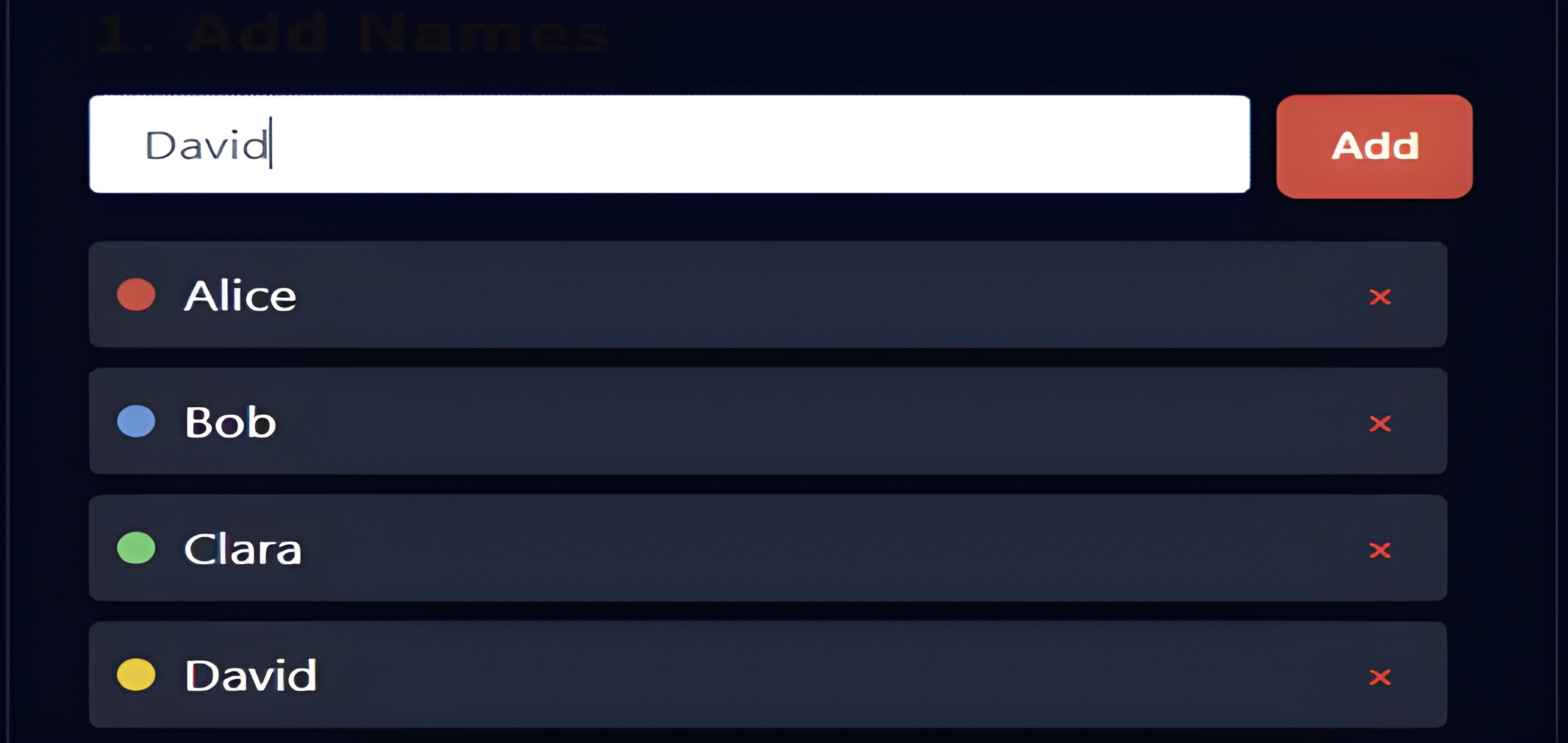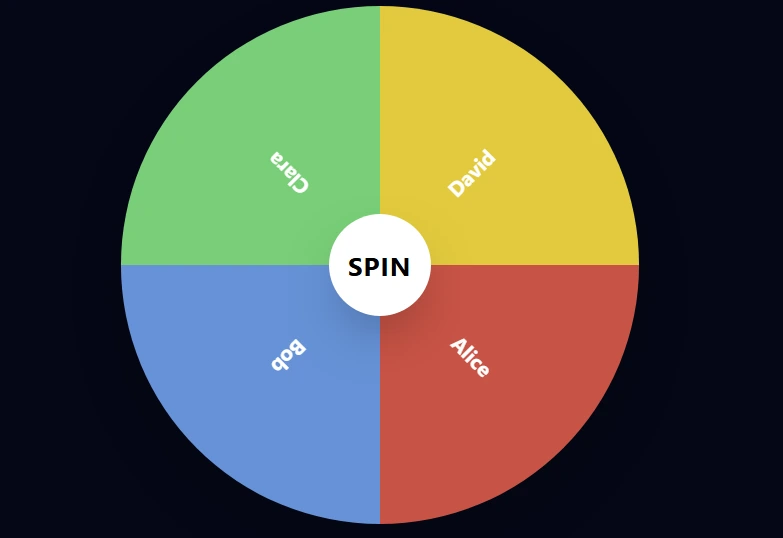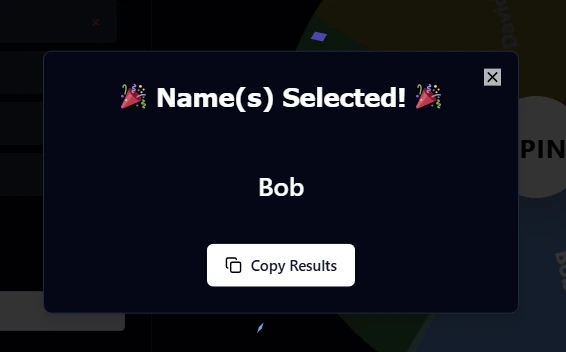Pick Names Fairly with Our Free Random Name Picker Wheel
Are you tired of manually choosing names for games, classroom activities, team challenges? Our free Random Name Picker Tool makes it easy, fun, and completely fair. No more arguments — just spin the wheel and let chance decide!
This intuitive name selector is perfect for teachers, team leaders, event organizers, and anyone who needs a quick, unbiased way to pick names at random.
How to Use the Name Picker
Using the tool is simple and requires no login or registration. Here’s how it works:


Step 2 – Set the Number of name to Select
Choose how many names you want to pick. Whether it’s one selected or multiple, the tool adapts instantly.
Step 3 – Spin the Wheel
Click the SPIN button and watch the wheel rotate with smooth animation. The result appears in a popup with confetti effects for a fun and engaging experience.


Step 4 – Reset and Start Over
Need to pick new names? Just click the RESET button to clear all names and start fresh.
Once the wheel stops, the selected name(s) appear in a dynamic popup with a playful animation. Colorful confetti adds a fun visual touch, making each draw feel interactive and engaging. The result is clearly highlighted, so there’s no confusion about who was picked.

Understanding Random Name Pickers: Technology and Purpose
A random name picker is a digital tool designed to select one or multiple names from a list using algorithmic randomization. Unlike manual selection methods that can be influenced by unconscious bias or predictable patterns, digital name pickers employ mathematical algorithms to ensure each entry has an equal probability of being chosen. This technology has become increasingly valuable in educational settings, corporate environments, event management, and anywhere fair selection is essential.
The mechanics behind random name selection rely on pseudo-random number generation (PRNG) algorithms. When you initiate a spin, the system generates random numerical values that correspond to positions in your name list. Modern web browsers utilize robust randomization methods, including implementations based on cryptographic standards, to ensure unpredictability and fairness. The visual spinning wheel animation adds an engaging element while the underlying algorithm handles the actual selection process independently of the visual display.
Random selection tools have evolved significantly over the past two decades. Early web-based versions offered simple text-based outputs, while contemporary tools incorporate interactive animations, visual feedback systems, and customizable features. This evolution reflects both technological advancement and a growing recognition of the importance of transparent, verifiable fairness in selection processes across various contexts.
The Psychology and Benefits of Random Selection
Human decision-making, even when attempting to be random, follows predictable patterns influenced by cognitive biases. Research in behavioral psychology demonstrates that when teachers manually select students for participation, they unconsciously favor certain patterns: calling on students in specific classroom locations more frequently, selecting those who make eye contact, or avoiding students who appear anxious. Studies indicate these biases can result in some students being called upon up to three times more frequently than others in the same classroom.
Random name pickers eliminate these unconscious biases entirely. Educational research has shown that classrooms implementing random selection tools experience measurable improvements in student engagement and participation equity. When students know selection is truly random, several positive effects emerge: increased alertness as everyone remains prepared to participate, reduced anxiety among students who worry about being singled out, and improved perception of fairness which enhances classroom culture.
The transparency of digital random selection builds trust in ways manual methods cannot match. When participants can see names being added to a visible wheel and watch the selection process unfold, they gain confidence in the fairness of outcomes. This transparency is particularly valuable in competitive contexts like raffles, contests, and prize drawings where the integrity of selection directly impacts participant satisfaction and legal compliance.
Time efficiency represents another significant advantage. Event organizers and teachers report substantial time savings compared to manual methods like drawing names from containers. Beyond the immediate time saved during selection, random tools eliminate the preparation time required for physical drawing systems and reduce disputes that can arise when manual selection methods are questioned.
Practical Applications Across Different Environments
Educational Settings and Classroom Management
Teachers utilize random name pickers for purposes extending far beyond simple question answering. In modern classrooms, these tools support various pedagogical strategies designed to maximize engagement and learning outcomes.
Cold calling with random selection keeps all students mentally engaged throughout lessons. When students know they might be called upon at any moment, attention levels increase significantly compared to volunteer-only participation models. Best practice involves using the tool to select a student, then providing brief thinking time before expecting a response, which reduces anxiety while maintaining preparedness.
Group formation represents another critical application. Research consistently demonstrates that randomly-formed groups produce more diverse perspectives and creative solutions than self-selected groups, which often reinforce existing social dynamics. Teachers can use name pickers to create groups of specific sizes for collaborative projects, ensuring exposure to different working styles and preventing the social isolation that can occur when students always choose the same partners.
Classroom job distribution benefits from random selection by eliminating perceptions of favoritism. Weekly roles like line leader, materials distributor, or technology assistant can be assigned fairly, giving all students equal opportunities for responsibility and recognition throughout the academic year.
Corporate and Professional Applications
Team leaders employ random selection for various professional scenarios where fair, unbiased assignment proves valuable. Icebreaker activities and networking events benefit from random pairing, helping employees build relationships across departmental boundaries they might not otherwise cross. This is particularly valuable in larger organizations where natural social networks tend to form within immediate work groups.
Task assignment in situations where multiple team members possess equal qualifications removes decision fatigue from managers while preventing any appearance of favoritism. When assignments are visibly random, team dynamics remain positive and individuals focus on performance rather than questioning assignment decisions.
Meeting facilitation improves with random selection of speakers or discussion leaders. Round-robin participation determined randomly ensures balanced contribution during brainstorming sessions and prevents domination by more vocal team members, leading to more comprehensive ideation and problem-solving.
Events, Contests, and Community Activities
Event organizers value random name pickers for their combination of fairness and entertainment value. Live raffle drawings gain excitement when conducted with visible spinning wheels that all attendees can watch. The anticipation built during the spin creates memorable moments that enhance event experiences.
Legal compliance represents a crucial consideration for contests and giveaways. Many jurisdictions require documented, verifiable randomization methods for promotional drawings. Digital random selection tools provide this documentation while offering transparency that protects organizers from disputes about selection integrity.
Tournament and bracket creation for competitions, game tournaments, or sports leagues requires fair initial seeding. Random selection eliminates arguments about favoritism in starting positions while creating unpredictable matchups that add interest to competitive events.
Comparing Random Selection to Alternative Methods
Traditional Manual Selection
Drawing names from containers represents the traditional approach to random selection. While this method has cultural familiarity and requires no technology, it presents several limitations. Physical manipulation of name entries creates opportunities for actual or perceived manipulation. The process is time-consuming, especially with large groups, and provides no automatic documentation of results. Verification requires trust in the person conducting the drawing, which may be questioned in high-stakes situations.
Sequential Selection Methods
Alphabetical order, seating arrangement, or roster sequence provides predictability but sacrifices the benefits of randomness. Predictable patterns allow participants to anticipate when they might be selected, reducing sustained engagement. Alphabetical systems create inherent bias favoring those whose names begin with early-alphabet letters, who experience repeated advantages across multiple contexts throughout their lives. Sequential methods offer no protection against systematic bias.
Volunteer-Based Selection
Requesting volunteers appeals to willing participants but creates significant equity issues. The same individuals tend to volunteer repeatedly while others never participate, reinforcing existing confidence gaps. Shy individuals or those from cultures where self-promotion is discouraged face systematic exclusion. Over time, participation opportunities become highly unequal, potentially impacting learning outcomes or professional visibility.
Digital Random Selection
Modern random selection tools combine provable fairness with practical advantages. Mathematical algorithms ensure equal probability for all entries, eliminating both conscious and unconscious bias. Instant results save time while visual interfaces provide transparency that builds trust. Documentation happens automatically, creating records valuable for verification or analysis. The primary requirement is access to a device with a web browser, which is widely available in contemporary educational and professional settings.
Maximizing Effectiveness: Strategic Implementation Tips
Classroom Implementation Strategies
Effective use of random name pickers in educational settings requires thoughtful integration into teaching practice. Establishing clear expectations at the beginning of the year helps students understand that random selection is a fairness tool rather than a punishment system. When students see the tool as ensuring everyone gets opportunities to participate, anxiety decreases and engagement increases.
Strategic timing matters significantly. Random calling works best during discussion-based activities where multiple perspectives add value, rather than during direct instruction of new concepts where student confusion might be high. Combining random selection with think-pair-share protocols provides students with processing time: select the name, allow thirty seconds for thought or partner discussion, then ask the selected student to respond.
Maintaining selection records helps ensure long-term fairness. While each individual selection is random, teachers can track overall patterns to verify that participation balances over weeks or months. If certain students haven’t been called recently, teachers might temporarily increase their representation in the selection pool.
Professional Environment Best Practices
Team leaders should frame random selection positively, emphasizing fairness and development opportunities rather than burden distribution. When being randomly selected feels like recognition or a growth opportunity rather than unwanted obligation, team dynamics benefit.
Contextualizing selections with clear expectations prevents confusion or anxiety. Immediately after revealing the random selection, provide specific information about the task, timeline, support available, and purpose. This clarity helps selected individuals transition smoothly into their assigned roles.
Backup planning addresses practical realities. What happens if the selected person is unavailable, ill, or already overloaded? Having a clear protocol for these situations prevents random selection from creating operational problems.
Event Organization Guidelines
Public display enhances transparency and excitement. Using screen sharing, projectors, or large displays allows all participants to witness the selection process, building trust while creating shared anticipation that enhances event atmosphere.
Result documentation protects both organizers and participants. Screenshots or recordings of selection processes provide verification if questions arise later about selection integrity or compliance with contest regulations.
Communication clarity before selection ensures all participants understand rules, eligibility, and any conditions attached to selection. This prevents disappointment or disputes after results are announced.
Historical Context: The Evolution of Random Selection
Random selection methods predate modern technology by millennia, reflecting humanity’s long-standing need for fair, unbiased decision-making in various contexts. Understanding this history provides perspective on why random selection remains valuable and trusted.
Ancient civilizations developed sophisticated random selection systems. Classical Athens used kleroteria, stone or wooden devices with random slots, to select citizens for jury duty and public offices. This system embodied democratic ideals by giving all eligible citizens equal opportunity to serve, preventing the concentration of power among elite families.
Medieval societies employed various chance-based methods for task assignment and decision-making. Drawing straws or lots determined everything from agricultural work assignments to military duties. These methods were seen as both fair and, in some contexts, as revealing divine will in situations where human judgment seemed inadequate.
The eighteenth and nineteenth centuries saw the formalization of lottery systems for both governmental and commercial purposes. Military conscription lotteries attempted to distribute service obligations fairly across populations. Commercial lotteries funded public works projects while offering ordinary citizens chances at wealth that were otherwise unattainable.
The twentieth century brought electronic randomization. Early computers developed for military and scientific purposes included random number generation capabilities essential for cryptography and simulation. As computing became more accessible, electronic random selection tools spread to various applications, from statistical research to game shows that captivated television audiences.
The internet era democratized access to random selection tools. Web-based generators eliminated the need for specialized equipment, making truly random selection available to anyone with browser access. Contemporary tools like interactive spinning wheels represent the latest evolution, combining rigorous algorithmic fairness with engaging visual presentations that make selection processes both trustworthy and entertaining.
Random Selection in the Digital Age
Modern random name pickers represent sophisticated implementations of randomization principles refined over decades of computer science research. Understanding what makes digital randomness reliable helps users trust these tools for important applications.
Quality random selection requires algorithms that produce statistically uniform distributions, where each possible outcome has equal probability across many trials. While true randomness derived from physical processes like atmospheric noise or radioactive decay exists, practical applications typically use pseudo-random number generators that produce sequences indistinguishable from true randomness for practical purposes.
Browser-based tools access randomization functions built into JavaScript and underlying browser engines. These implementations have undergone extensive testing and refinement to ensure quality randomness suitable for applications from gaming to cryptographic key generation. While not suitable for the most demanding cryptographic applications requiring specialized hardware random number generators, these browser-based methods provide more than sufficient randomness for name selection, ensuring fairness equivalent to any physical method.
Transparency in implementation builds user trust. Open discussion of the algorithms and methods used for randomization helps users understand that selections are genuinely fair rather than predetermined or manipulated. This transparency distinguishes legitimate random selection tools from applications where apparent randomness might conceal predetermined outcomes.
The future of random selection tools likely includes enhanced features while maintaining core fairness principles. Integration with learning management systems or professional collaboration platforms could streamline workflows. Analytics tracking selection patterns over time could help ensure long-term fairness. Accessibility improvements will make these tools usable for individuals with various disabilities. Throughout these developments, the fundamental value proposition remains unchanged: providing provably fair, unbiased selection that users can trust for applications where fairness matters.
Key Features
No Login Required
Use instantly — no account, no email, no setup.
Unlimited Names
Add as many names as you need — no restrictions.
Dual Theme
Switch between light and dark mode for comfort in any setting.
Unique Colors
Each name appears in its own vibrant color on the spinning wheel.
Visual Feedback
Confetti animation and result popup make every pick exciting.
Mobile-Friendly
Works flawlessly on smartphones, tablets, and desktops.
100% Free Forever — No hidden fees, no premium tiers, no ads during use. Just pure, instant randomness.
Perfect For
Teachers
Randomly select students for questions, presentations, or group work. Ensures fairness and keeps everyone alert.
Team Leaders
Pick volunteers for tasks, meetings, or icebreakers — ideal for remote or in-person teams.
Event Organizers
Make group selections fun and engaging. The animated wheel turns every draw into a shared moment.
Why Choose Our Name Picker?
Unlike basic random name generators, our tool delivers a visually rich, interactive experience with smooth animations, color-coded names, and instant feedback. It’s built for fairness, simplicity, and joy — all in one free, privacy-respecting tool.
And best of all? It loads instantly and works fully in your browser — no waiting, no lag.
Try More Tools on Spin Numbers
Looking for more ways to add randomness and fun to your day? Explore our main tool, Spin Numbers, where you can randomly pick numbers, create custom wheels, and generate results for games, classroom activities, and team decisions.
Go to Spin Numbers →Note: All tools on Spin Numbers run locally in your browser. No data is collected, stored, or shared. Perfect for schools, teams, and personal use.
Frequently Asked Questions
Is this name picker really free?
Yes! The tool is 100% free to use. No subscriptions, no trials, and no hidden costs — ever.
Do I need to create an account?
No login or registration is required. Just open the page and start adding names instantly.
Can I pick multiple selections?
Yes! You can choose how many names to draw — from 1 up to all names on the wheel.
Does it work on mobile phones?
Yes, the tool is fully responsive and works perfectly on smartphones, tablets, and desktops.
Are the results truly random?
Yes! The tool uses JavaScript’s secure randomization algorithm to ensure fair, unbiased, and unpredictable results.
How are colors assigned to names?
Each name is automatically assigned a unique, vibrant color to enhance visual clarity and engagement on the spinning wheel.
Can I remove a name after adding it?
Currently, you can reset the entire wheel by clicking “Setup” again or refreshing the page to start fresh.
Is my data saved or shared?
No. All processing happens locally in your browser. We don’t collect, store, track, or share any names or usage data.
Can I use this in my classroom?
Absolutely! Teachers worldwide use this tool for fair student selection, group assignments, icebreakers, and classroom games — all while keeping students engaged and included.

 Instagram
Instagram